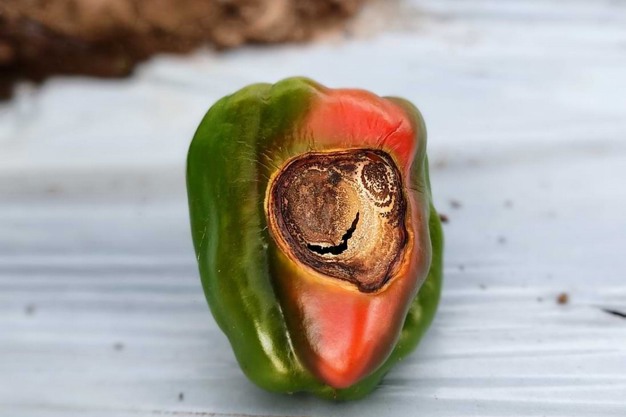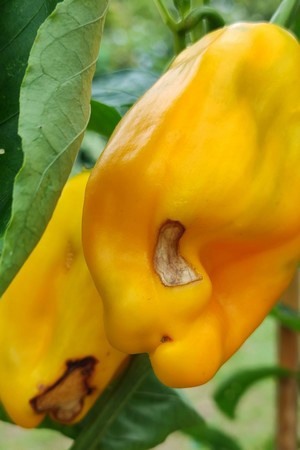Blossom end rot (BER) remains a persistent challenge for growers of tomatoes, peppers, eggplants, and cucumbers. As discussed briefly, while it is commonly linked to calcium deficiency, the reality is far more complex. According to Dr. Emilia Mikulewicz, Founder of Cultiva EcoSolutions, BER is not merely a result of calcium scarcity in the substrate but rather an issue of ineffective calcium transport within the plant.
"Many growers conduct soil or nutrient solution analyses and see adequate calcium levels, yet their crops still suffer from BER," she explains. "This is because calcium transport is significantly stronger in the leaves than in the fruits. As a result, fruits receive the least calcium, making them the first to show deficiency symptoms."
 © Tinneke Hattingh | HortiDaily.comSymptoms of Blossom End Rot on bell pepper – caused by calcium deficiency and unstable soil moisture.
© Tinneke Hattingh | HortiDaily.comSymptoms of Blossom End Rot on bell pepper – caused by calcium deficiency and unstable soil moisture.
The hidden causes of BER
One of the most overlooked factors contributing to BER is the disruption of the calcium-potassium-magnesium (Ca:K:Mg) balance. "Both potassium (K) and magnesium (Mg) can block calcium transport in plant tissues. Additionally, an excess of ammonium (NH₄⁺), which is common in many fertilizers, strongly inhibits calcium movement and intensifies BER."
Environmental conditions also play a critical role. Low relative humidity, high electrical conductivity (EC), and overly rapid generative growth can all hinder calcium transport to the developing fruit. "An excessive fruit load further complicates the issue," she notes. "The plant struggles to distribute calcium effectively, and young fruits, which have a low transpiration flow, are especially susceptible to deficiency."
 © Tinneke Hattingh | HortiDaily.comMore calcium isn't always the answerOne surprising finding in BER research is that calcium levels in affected fruits can sometimes be high, yet the disorder still occurs. "Calcium may be present but bound in insoluble complexes, such as with oxalic acid. What really matters is the calcium content in the cell sap, not just the total calcium in the fruit."
© Tinneke Hattingh | HortiDaily.comMore calcium isn't always the answerOne surprising finding in BER research is that calcium levels in affected fruits can sometimes be high, yet the disorder still occurs. "Calcium may be present but bound in insoluble complexes, such as with oxalic acid. What really matters is the calcium content in the cell sap, not just the total calcium in the fruit."
Photo right: Advanced Blossom End Rot (BER) symptoms on yellow bell pepper. A physiological disorder caused by impaired calcium uptake and irregular watering.
This means that simply increasing calcium fertilization does not always solve the problem. "Adjusting irrigation strategies, maintaining the vegetative-generative balance, and managing EC often yield better results than adding more calcium," she says. "Plants growing too fast generatively experience a dilution effect, where available nutrients become too spread out to be effectively utilized."
Practical solutions for calcium transport
Dr. Mikulewicz emphasizes that growers must consider the broader physiological and environmental conditions affecting calcium uptake. "In my work, I often observe that even with good humidity and fertilization, cold roots can inhibit calcium absorption, especially at night. When substrate temperatures drop below 18°C, calcium transport is significantly reduced."
Moreover, strong air movement near the leaves can exacerbate the problem. "High transpiration rates in the leaves divert calcium away from the fruits. This is why irrigation systems play a crucial role. Micro-irrigation with frequent small doses supports more stable calcium transport and helps prevent BER."
Don't stop at the lab results
For growers struggling with BER despite favorable soil or nutrient solution analyses, Dr. Mikulewicz encourages a shift in perspective. "Instead of focusing solely on calcium levels, we need to understand how calcium moves within the plant and what factors influence its availability to the fruit," she advises. "By optimizing irrigation, environmental conditions, and nutrient balance, growers can significantly reduce BER and improve fruit quality."
For more information:![]()
Cultiva EcoSolutions
Dr Emilia Mikulewicz, Ph.D.
Email: contact@cultivaeco.com
LinkedIn: www.linkedin.com
cultivaeco.com
